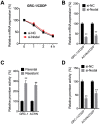Nodal is involved in chemoresistance of renal cell carcinoma cells via regulation of ABCB1
- PMID: 33754002
- PMCID: PMC7974526
- DOI: 10.7150/jca.52092
Nodal is involved in chemoresistance of renal cell carcinoma cells via regulation of ABCB1
Abstract
Renal cell carcinoma (RCC) is the third most frequent malignancy within urological oncology. Understanding mechanisms of chemoresistance in RCC cell is important for therapy and drug development. We established cisplatin (CDDP) resistant RCC cells by treating cells with increasing concentrations of CDDP. Nodal, an important embryonic morphogen, was increased in RCC/CDDP cells. Targeted inhibition of Nodal via its siRNA or neutralization antibody restored sensitivity of RCC resistant cells to CDDP treatment. It was due to that si-Nodal can decrease expression of P-glycoprotein (P-gp, encoded by ABCB1), one important ATP-binding cassette (ABC) membrane transporter for drug efflux. si-Nodal can decrease the transcription and promoter activity of ABCB1. Mechanistically, si-Nodal can decrease the phosphorylation of p65, which can bind to the promoter of ABCB1 and then trigger its transcription. Further, CDDP treatment decreased the expression of Nodal in culture medium of RCC cells. Collectively, we found that Nodal can regulate chemoresistance of RCC cells via regulating transcription of ABCB1.
Keywords: Nodal; P-gp; RCC; p65; transcription.
© The author(s).
Conflict of interest statement
Competing Interests: The authors have declared that no competing interest exists.
Figures







Similar articles
-
Oestrogen-related receptor alpha mediates chemotherapy resistance of osteosarcoma cells via regulation of ABCB1.J Cell Mol Med. 2019 Mar;23(3):2115-2124. doi: 10.1111/jcmm.14123. Epub 2019 Jan 4. J Cell Mol Med. 2019. PMID: 30609256 Free PMC article.
-
Histone deacetylase 6 regulated expression of IL-8 is involved in the doxorubicin (Dox) resistance of osteosarcoma cells via modulating ABCB1 transcription.Eur J Pharmacol. 2018 Dec 5;840:1-8. doi: 10.1016/j.ejphar.2018.09.032. Epub 2018 Sep 28. Eur J Pharmacol. 2018. PMID: 30273544
-
Oncogenic PITX2 facilitates tumor cell drug resistance by inverse regulation of hOCT3/SLC22A3 and ABC drug transporters in colon and kidney cancers.Cancer Lett. 2019 May 1;449:237-251. doi: 10.1016/j.canlet.2019.01.044. Epub 2019 Feb 10. Cancer Lett. 2019. PMID: 30742940
-
Autophagy regulates cisplatin-induced stemness and chemoresistance via the upregulation of CD44, ABCB1 and ADAM17 in oral squamous cell carcinoma.Cell Prolif. 2018 Feb;51(1):e12411. doi: 10.1111/cpr.12411. Epub 2017 Nov 23. Cell Prolif. 2018. PMID: 29171106 Free PMC article.
-
Kanglaite enhances the efficacy of cisplatin in suppression of hepatocellular carcinoma via inhibiting CKLF1 mediated NF-κB pathway and regulating transporter mediated drug efflux.J Ethnopharmacol. 2021 Jan 10;264:113388. doi: 10.1016/j.jep.2020.113388. Epub 2020 Sep 10. J Ethnopharmacol. 2021. PMID: 32918990
Cited by
-
Association of SLC12A1 and GLUR4 Ion Transporters with Neoadjuvant Chemoresistance in Luminal Locally Advanced Breast Cancer.Int J Mol Sci. 2023 Nov 9;24(22):16104. doi: 10.3390/ijms242216104. Int J Mol Sci. 2023. PMID: 38003293 Free PMC article.
References
-
- Chen W, Zheng R, Baade PD, Zhang S, Zeng H, Bray F, Jemal A, Yu XQ, He J. Cancer statistics in China, 2015. CA Cancer J Clin. 2016;66:115–132. - PubMed
-
- Cai Z, Liu Q. Understanding the Global Cancer Statistics 2018: implications for cancer control. Sci China Life Sci. 2019. - PubMed
-
- Barata PC, Rini BI. Treatment of renal cell carcinoma: Current status and future directions. CA Cancer J Clin. 2017;67:507–524. - PubMed
-
- Ljungberg B, Campbell SC, Cho HY, Jacqmin D, Lee JE, Weikert S, Kiemeney LA. The Epidemiology of Renal Cell Carcinoma. European Urology. 2011;60:615–621. - PubMed
-
- Grimm MO, Foller S. Immunotherapy for renal cell carcinoma - current status. Aktuelle Urologie. 2018;49:187–191. - PubMed
LinkOut - more resources
Full Text Sources
Other Literature Sources
Miscellaneous

